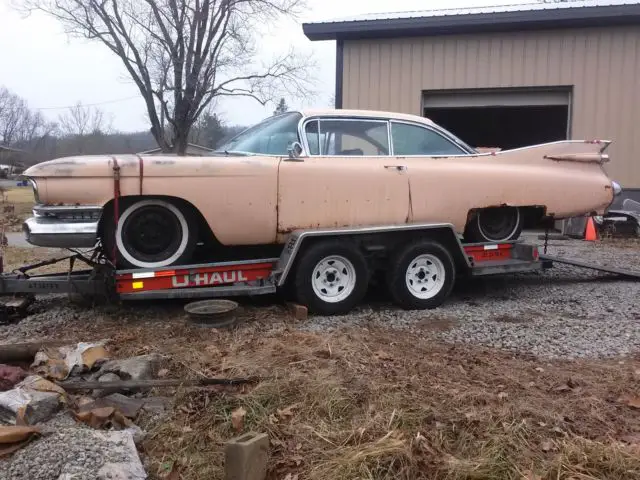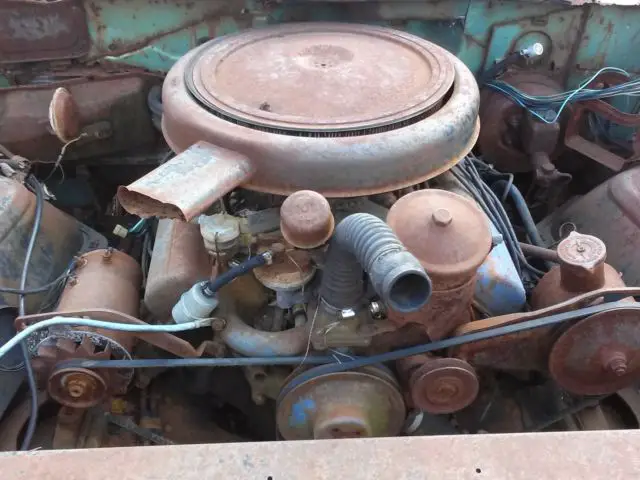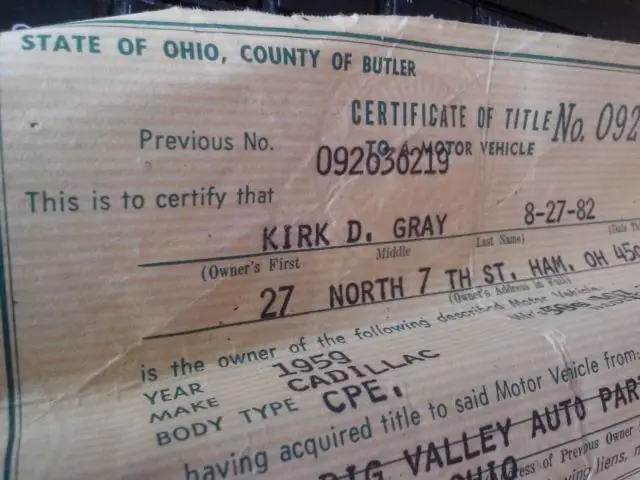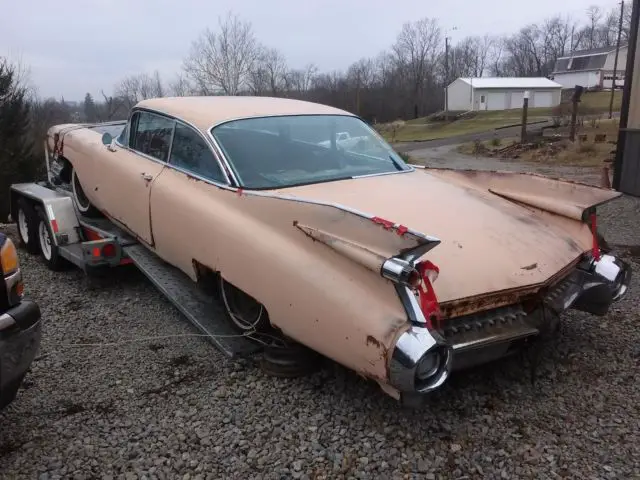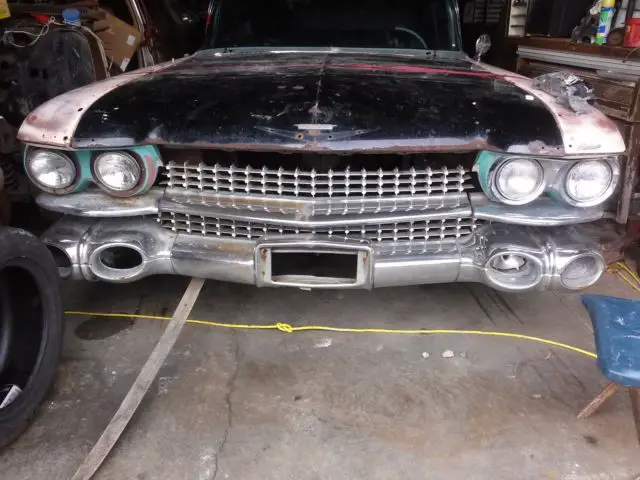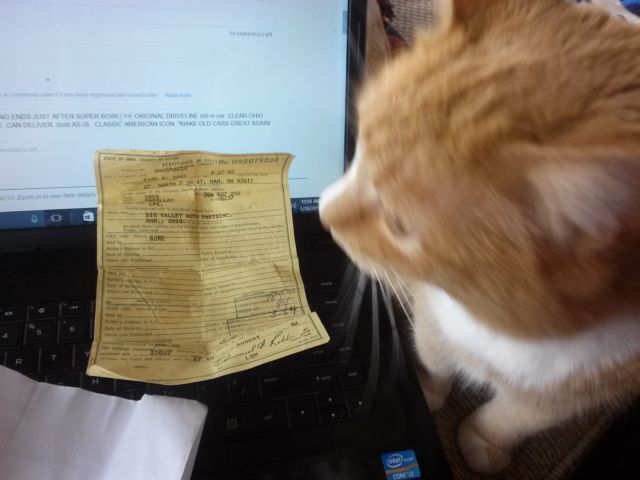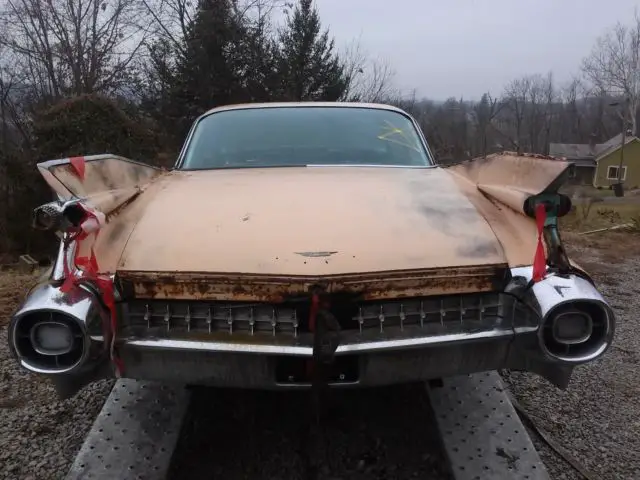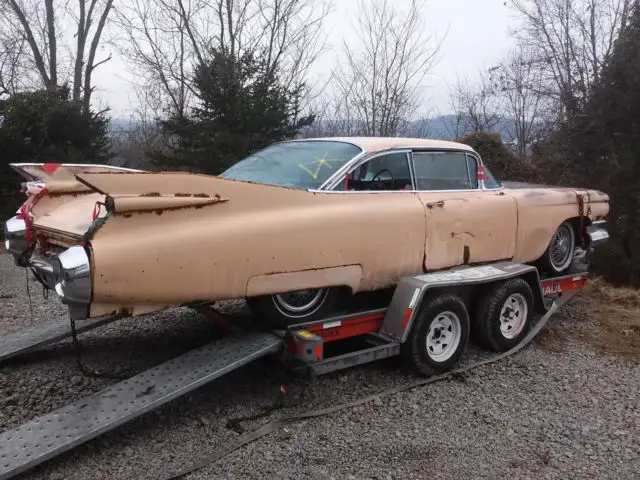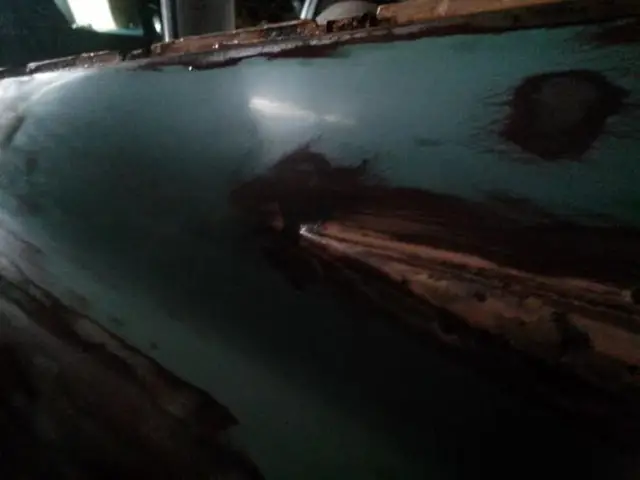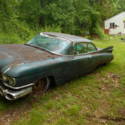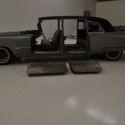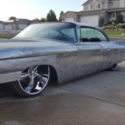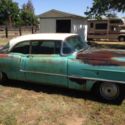1959 2DOOR CADILLAC PROJECT cts-v gto rolls ferrari corvette gt ss xlr 442 rod z
| Make: | Cadillac |
| Model: | DeVille |
| Type: | Coupe |
| Year: | 1959 |
| Mileage: | 15,000 |
| VIN: | 59 G 107252 |
| Color: | Green |
| Engine: | Caddy 390 4 bbl |
| Cylinders: | 8 |
| Fuel: | Gasoline |
| Transmission: | Automatic |
| Drive type: | RWD |
| Interior color: | Green |
| Vehicle Title: | Clear |
| Item location: | Logan, Ohio, United States |
1959 Cadillac DeVille Additional Info:
THIS IS A NO RESERVE AUCTION SALE-SELLER WILL HELP BUYER SET UP SHIPPING either domestic or worldwide-
or seller canDELIVER TO SOME Eastern and Midwest U.S. DESTINATIONS.
ALL Shipping/Delivery costs are buyer's responsibility.
as you can see from pics--the Big Cadfits on a U-HAUL AUTO TRANSPORT---THIS MEANS delivery is a snapvia seller/ my GMC pick-up truck/ and fuel -
I can have this car delivered to you in a matter of a few days / depending on where you live ; towing it myself. BUY THIS GREAT CAR / buy it now, check the oil in your air compressor and restore this one yourself.Repaint it the cool original GM Green or modify this monster and create your dream car.
This auction style sale will transfer ownership ofthe TWO-DOOR 1959 CADILLAC 325 HP /390 CID V-8 pictured and described in this EBAY listing.
ACTUAL MILEAGE UNKNOWN.
This beautiful car with itsdesign taken from P-38 Fighter Planesis looking for a caring new home,Loving TLC and a driver/ownerwho enjoys the fun and special times this car will deliver.
In very original condition the58 year-old Caddy needs total restoration.
buy it and HAVE IT YOUR WAY
Overall the body is VERY STRAIGHT with attention needed mostly on the PASSENGER SIDE DOOR. Thepassenger side fender has an easily repairabledent low down toward the rear of the fender. (pics) The trunk lid rear flap and rear body panel above bumper needssome repair.
Original seats are with car needing re-upholstery.
The car will need full restoration, a few parts and pieces here and there,floor patching and the trunkhasareas to repair. Chrome is presentable for a driver car / for a Concours type show car buyer will want to re-chromepieces.
THE CAR IS RESTORABLE with TONS OF POTENTIAL
Once the CADDY receives bids here I can not add photos---BUT-- contact seller and I will take any additional pics and email them to you directly.
Communication is invited and seller may consider interesting cars or projects as part of payment.
This auction is a no reserve/ low starting price auction with a low buy it now price.Buyer should realize the car needs restoration. The frame is solid and the body is not bad for the car's age. The lower sections of some areas of door (s) and qps/fenders will need repair. Car sold as-is / no refunds. Feel free toinspect the car in 43138 / S.E. Ohio. Buyer should ask for any pics desired as sale is final.
The motor is complete from the air cleaner to the fan belts. The radiator is not with the car. As of posting time I have not fired up motor. Motor is said to run and drive according to previous owner. I plan to "pickle" motor with Marvel Mystery Oil in the cylinders and attempt to fire engine but for now the car is being offered without the motor being started. Buyer can expect cylinders to be lubricated.
The new owner should either be able to work on cars themselves or have a body shop they are confident in to repair the car. The car is very restorable, will be a rewarding project and will needplenty of work done to it.
Originally beautiful Green in and out this cool CADDYwould be beautiful in original colors and of course
'59 customs are just too cool.
Create your dream car using this solid platform.
Once again...to ease delivery coordination, seller can deliver. Sellermust rent trailer and ALL COSTSassociated with delivery will be BUYER'S to be determined and paid for before delivery.
Of course BUYER may make shipping arrangements themselves.
This 1959 is also for sale locally and on c/l.
Buy it now to secure the car or contact buyer to finalize as seller reserves right to end listing.
taken from HAGARTY:
Model Overview History of the 1959-1960 Cadillac Series 62 Cadillac dramatically reworked its model lineup for the 1959 model year. The Series 62s received a toothier grille, a dummy grille across the tail, bright window surrounds, and a trim spear along the side. Most famously, a gargantuan fin topped each rear fender, with taillights on each side. The 62s also had rear fender skirts. There were four body styles in the Series 62 – four- and six-window hardtop sedans, a two-door hardtop coupe, and a convertible.
The six-window sedans had a curved rear window, like the coupe, while the four-window sedans were known as “flattops” with a rear drip-rail and wraparound rear window. Series 62s were the most affordable Cadillac at $4,800 to $5,400, and the model was a sales leader for the division at nearly 71,000.
The Cadillac 390-cid V-8 developed 325 horsepower, Hydra-Matic transmission was standard, and most of the accessories now taken for granted on Cadillacs were offered by this time: power steering, windows, brakes, and seats, as well as air conditioning. Air suspension was optional.
Cadillac’s designers dialed back the 1960 Series 62 a bit. Gone were the twin rocket taillights, the fins were reduced in size, and taillights were placed in the rear fender caps. The same body designs were offered in both 6200 and 6300 series, with the same options and engine. Series 62 sales totaled just under 80,000, with the six-window hardtop sedan accounting for nearly a third of the units.
The extravagance of the 1959 Cadillacs has made it an icon of the era, and values reflect that status. Interest in the 1959 Cadillac Series 62 in particular has led to a lot of cars being restored. The 1960 models largely missed this boom, but as a result, there are better original examples to be found. Regardless, both years are quite sound mechanically and are a joy to own, provided you can live with 10 mpg and have a garage large enough to park the nearly-20-foot-long car.
" ng-click="vm.trackHemmingsLink($event)" notouch="" hvt-set-active="vm.isActive" ng->- 0">
- Engine Types
- 8-cyl. 390cid/325hp 4bbl
- 8-cyl. 390cid/345hp 3x2bbl
- Additional Info
- Curb Weight: 4690 lbs.
- Vehicle Length: 225 in.
- Wheel Base: 130 in.
- Number Produced
- 21,947
- MORE FROM WWW
The '59 Caddy had it all -- looks, performance, and comfort. It stood as the ultimate symbol of success, impressive and -- yes -- controversial. The outrageous tail fins and jet pod taillights evoked either a love it or leave it attitude with the public. It is interesting to note that Maurice D. Hendry, author of Cadillac: Standard of the World, The Complete Seventy-Year History, refused to include a picture of the regular production '59 Cadillac in his book. He said that, "This year saw the tail fins reach a literally ridiculous height.... The fins had plenty of critics including this writer.... Nevertheless, the 1959s overall were excellent.... As cars -- rocket fins or not -- they were undeniably excellent."
Walter M. P. McCall, in 80 Years of Cadillac-LaSalle agreed, commenting that the 1948 tailfins "soon became Cadillac's most famous styling feature, but with each successive series of new cars these rear fender appendages grew higher and more flamboyant. By the late 1950s they had reached ludicrous proportions and were of questionable taste." He called them "Cadillac's spectacular 'zap' fins!" Up front, McCall observed that "The new grille was a glittering cliff of chrome. And as if one toothy grille wasn't enough there was even a dummy grille across the lower rear deck of most models. A thin, horizontal blade divided the jewelled front grille into upper and lower sections. Parking and turn signal lights were paired in pods at the outer ends of the massive new front bumper. The new rear bumper had huge, chrome outer pods with backup lights recessed in their centers."
Of course, just about everybody knows about the monster fins on the '59 Cadillac. But how many have ever heard about the Cadillac designed around a Buick door? The 1959 Cadillac was. General Motors had gone through three expensive years of tooling up for new models and the head honchos wanted to trim costs. They decided to make the basic Buick front door a common interchangeable element throughout the GM C-body line. This was a tough directive because the door tapered rearward, but an order was an order and the Cadillac design team worked around it, turning out an unforgettable product in the process.
Dave Hols, now Director of Design with the General Motors Design Staff, was a designer at the Cadillac styling studio in 1956. He remembers the Buick door challenge quite well. "Boy, did you guys see those '57s parked down at the end of Mound Road?, " Hols recalls one designer asking as he came into the studio one morning. The designer was referring to the befinned 1957 Chrysler cars. Actually, Cadillac had started the great automotive fins race in 1948 after styling chief Harley Earl had sent a group of designers out to Selfridge Field near Detroit to study a Lockheed Lightening P-38, particularly its rear stabilizers. Now, almost a decade later, Chrysler's cars were out-finning Cadillac -- and in a bold way at that. In point of fact, Chrysler had temporarily wrested design leadership from GM, and that could not be tolerated.
Thus, Chrysler's challenge set the Cadillac design team's creative course -- the '59 Cadillac was going to have flamboyant fins. All the designers were disenchanted (some to the point of hate) with the '58 Caddy and they were going to abandon most of its design themes. And just as the 1958 Lincoln and Continental Mark III set out to "out-Cadillac" Cadillac in 1958, Cadillac found itself in the curious situation of trying to "out-Chrysler" Chrysler in 1959!
Retired Vice-President of Design, Bill Mitchell, remembers the battle with Chrysler. "I think what happened is that at the time [Virgil] Exner at Chrysler and we at GM tried to out-fin each other. I think the worst year we had was '58 when we were putting on chrome with a trowel. We had chrome on everything, and in '59 we tried to out-fin Exner. You know, we went on to '60 and '61 and brought the fins down and made them a little more sane -- a little more 'sanitary.'"
The head of GM styling at the time was Harley Earl, the Father of modern automotive design. But he was away in Europe when this inspiration came to the Cadillac design staff. "When the cat's away...."
Every designer on the project was enamored of jet aircraft. It was nothing to see a stack of books on the subject on their desks. This was an exciting time in aviation and the designers were awed by the shapes of the latest jets. True, the P-38 influence continued on the '59 Cadillac with the flow-through lines. As Mitchell said, "Seeing the P-38, you saw how you could go from the headlight straight back to the tailfin in one line." But, as Hols puts it, "By the mid-Fifties, jet aircraft were the thing." If you look at the rear of the '59 Caddy, it looks like the exhaust ports of a jet. It's no wonder the '59 Caddy looks like it's really moving even when it's just sitting in the driveway.
All the right ingredients came together for the creation of the '59 Cadillac. First, GM was doing all-new vehicles for 1959. Second, the taper in the Buick door dictated Cadillac's rearward taper. Finally, Ed Glowacke, head of design at Cadillac, wanted a new, innovative, state-of-the-art design. Cadillac could do nothing less than Chrysler and still be competitive, Glowacke thought. So he put his crew on a rush schedule to get the 1959 design completed. Work began about October 1956, with the car set for an October 1958 introduction. Compared to other GM design time-tables, that was incredibly fast and meant many late hours in the studio.
Dave Hols, working with Glowacke and crew, developed the distinctive tailfin design. Twin taillights were used because twice as many looked more expensive. Thus, nacelles were designed into the tailfins to allow for them. Chuck Puhlman and Roy Hill also worked on the design. In the end, use of the Buick door cost more than originally projected, mainly because of the taper and drop in height. Without that taper, however, the car's lines wouldn't have carried the characteristic sweep of motion that became such a distinctive part of the car's design -- and certainly we would not have seen those huge fins.
One of the most striking impressions one receives from inside the '59 Cadillac is a marvelous feeling of openness. That's because 1959 was also the "greenhouse year" at GM. The entire lineup boasted unexcelled visibility compliments of the thin pillars and abbreviated sail panel (really only a pillar itself). Sitting in the car, the driver could easily see all four corners and enjoy an almost unobstructed view in all directions. Part of the increase in visibility had to do with the design of the roof. In fact, the buyer could choose from two distinctive roof designs, the first a more traditional curved roof, the second a radical "blade-upper" flat roof. Both lent themselves to creating lavish vistas of visibility.
Interior planning for the 1959 Cadillac, including the Eldorado Brougham and limos, was directed by Bob Scheelk, head of Cadillac interior design. He remembers the project as a rush program; he was asked to have the instrument panel in clay -- with working instrument lights -- for the GM Board of Directors at the Tech Center in the spring of 1957, a monumental task. As it turned out, the executives approved the instrument panel for production pretty much as presented. It was quite deep because of the depth of the cowl and the rake of the wraparound windshield, which resulted in an extended shelf. Also working on the interior were Sue Vanderbilt (who had worked on Cadillac exteriors earlier); Russ Bolt, a studio engineer; and two clay modelers.
Of course, Cadillac shared a number of parts with other GM cars, mainly the structural pieces hidden from view. Cadillac's interior also shared components with its GM siblings -- items like door moldings and openings, window surrounds, and seat frames. But most of what the buyer saw, including the seat cushions and fabrics, was unique.
The extreme curvature of the windshield caused some rethinking regarding placement of controls and switches. For example, the section of the dash which curved around on the driver's side to the door opening was large enough that the designers referred to it as the "horn." On it, they placed the windshield-wiper controls and the power window switches. Originally, the cruise control was located there, too, but it had to be moved because it conflicted with the other controls.
Because so many components were new, even the door opening mechanism for example, extra care had to be taken to maintain Cadillac's reputation for high quality. One problem in this regard was the metallic fabric used on the Fleetwood Sixty Special; it trapped the guard-hairs of women's mink coats when they sat down and hung onto the hairs when they got up. This textile problem was rapidly addressed and solved.
Scheelk came up with the colors, had some cars painted, and hosted an outdoor color show for management at Cadillac engineering on Clark Street. There, a vote was taken. Only after the formulas for the selected colors were developed and the problems worked out did the colors receive final approval. Cadillac often boasted about its Magic-Mirror acrylic lacquer finish.
All 1959-60 Cadillacs came with Hydra-Matic, power steering, and power brakes as standard. They also featured a new direct-acting power brake booster and automatic-release parking brake. Of course, there was a long list of options: cruise control, air suspension (whose shocks now contained plastic bags of inert Freon-12 so that the gas could not mix with the shock absorber fluid), electric door locks, Autronic Eye headlight dimmer, power windows and seat, air, E-Z Eye glass, power trunk with pull-down, and more.
The '59 Caddy rode a 130-inch wheelbase and stretched 225 inches from bumper to bumper. At 54.8 inches, the two-door hardtop stood three inches lower than it had the previous year. Cadillac used a tubular-center X-frame, not only for its exceptional strength, but also because it allowed for a low body to improve appearance and enhance handling stability. The V-8 was bored for 1959, upping the displacement from 365 to 390 cid and the horsepower from 310 to 325. A four-barrel carb and dual exhausts were standard. Even the car's rear end, available with four ratios from 2.94:1 to 3.77:1, had been redesigned, but mainly for a quieter ride.
DeVille now became a distinct series, offering hardtop sedans with flat-top four-window styling and a curvier six-window roofline, plus a hardtop coupe. The Series 62 duplicated these, and added a convertible. Still pillarless (as it had since been since '57), the lush Sixty Special now shared a new 130-inch wheelbase with all other standard models, including the line-topping Eldorado trio of Seville, Biarritz, and Brougham.
Prices were generally higher than before, with Series 62s at around $5000 and Eldos going for $7400 and up. Still, Cadillac built over 142,000 of its '59s, a fair gain on its 1958 showing. Though not appreciated then, these Caddys are now sought-after as the epitome of Fifties kitsch with their massive size, sparkling trim, and, especially, those overblown fins.
Despite a few lapses, the Fifties had been a great 10 years for Cadillac -- the greatest ever in terms of expansion. A car for the very wealthy in 1950, Cadillac was solidly entrenched by decade's end among younger buyers on the way up.
In 1959, Cadillac fielded six series: Series 6200, 6300 (DeVille), 6400 & 6900 Eldorados, Sixty Special Fleetwood, and 6700 Fleetwood 75.
SERIES 6200
No single automotive design better characterizes the industry's late Fifties flamboyance than the 1959 Cadillac, which incorporated totally new styling:- Large tailfins
- twin bullet taillamps
- two distinctive rooflines and roof pillar configurations
- new jewel-like grille patterns
- matching deck latch lid beauty panels. The former 62 line was now commonly called the 6200 Series and was actually comprised of three sub-series all with similar wheelbases and lengths. Each will be treated individually here. The five base models were identifiable by their straight body rub moldings running from front wheel openings to back bumpers with crest medallions below the tip of the spear. A one-deck jeweled rear grille insert was seen. Standard equipment included
- power brakes
- power steering
- automatic transmission
- dual backup lamps
- windshield washers and two-speed wipers
- wheel discs
- outside rear view mirror
- vanity mirror
- oil filter
- 1959 CADILLAC
1959 CadillacPrev Up Next Cadillac's 1959 models, like this eye-catching 1959 Cadillac Eldorado Biarritz, sported a new, more curvaceous body.As flamboyant as the 1958 Cadillacs appeared, there was another styling frontier ahead. That threshold was crossed with the immortal 1959 Cadillac.
GM gave its division's largest cars, the so-called C-bodies, another new basic design for 1959. For Cadillac, that meant more-curvaceous styling devised as a hurried reply to Chrysler's resurgent '57 Imperials.
Hallmarks included huge curved-top windshields, thin-section rooflines, slim roof pillars -- and soaring fins of heroic proportions, adorned with high-riding bullet taillamps.
Offsetting such excesses were worthy suspension changes and improved power steering. In addition, a V-8 stroked to 390 cubic inches produced predictably higher horsepower: to 345 on Eldorados, to 325 on other models.
The Cadillac De Ville became a distinct series for 1959, offering hardtop sedans with flat-top four-window styling and a rounded six-window roofline, plus a hardtop coupe.
The 1959 Cadillac Series 62 duplicated these body styles, and added a convertible.
After just two years and 704 units, the 1959 Cadillac Eldorado Brougham was fully restyled, too. Moreover, assembly was farmed out to coachbuilder Pininfarina in Italy. Only 99 Eldorado Broughams were built for '59, another 101 of the near-identical '60s. Though appearance was clean (a preview of Cadillac's 1961 styling, as it turned out), these cars were larger (on a 130-inch wheelbase), heavier, and not put together as well (bodies contained lots of lead filler). They're collector's items now, but restoring one is a chore.
Also still pillarless (as it had been since 1957) was the lush 1959 Cadillac Sixty Special, now on the 130-inch wheelbase shared with other standard models, including the line-topping Eldorado Seville, Biarritz, and Brougham.
Cadillac prices were generally higher for 1959, with Series 62 models at around $5,000 and the 1959 Cadillac Eldorado going for $7,400 and up. Still, Cadillac built more 142,000 cars for the model year, a fair gain on 1958.
The 1959 Cadillac Series 62 hardtop is another example of evocative 1959 Cadillac styling.At the time, of course, it took some foresight, or a certain contrarian outlook, to believe that American car styling had reached some outlandish zenith with the 1959 Cadillac. But even within GM there was a sense that things had to be dialed back, and indeed they were, beginning in 1960.
What can't be disputed is that the 1959 Cadillacs, defined by those saber-edged fins and projectile taillamps, are among the most evocative objects of the 20th Century. What precisely they evoke is open to interpretation, and that's part of the magic.
- 1959 CADILLAC
On Jan-29-17 at 19:30:45 PST, seller added the following information:
PINK PAINT SANDS OFF NICELY TO ORIGINAL PAINT---there is the original green and primer---under pink and red oxide primer---
whoever painted it D/A ed it to remove scratches---I have not found any bondo yet--
On Jan-30-17 at 14:14:54 PST, seller added the following information:
RESEARCHING THE TRIM TAG SHOWS THIS CAR IS A RARE TWO-TONE CAR -DOVER WHITE OVER INVERNESS GREEN-
